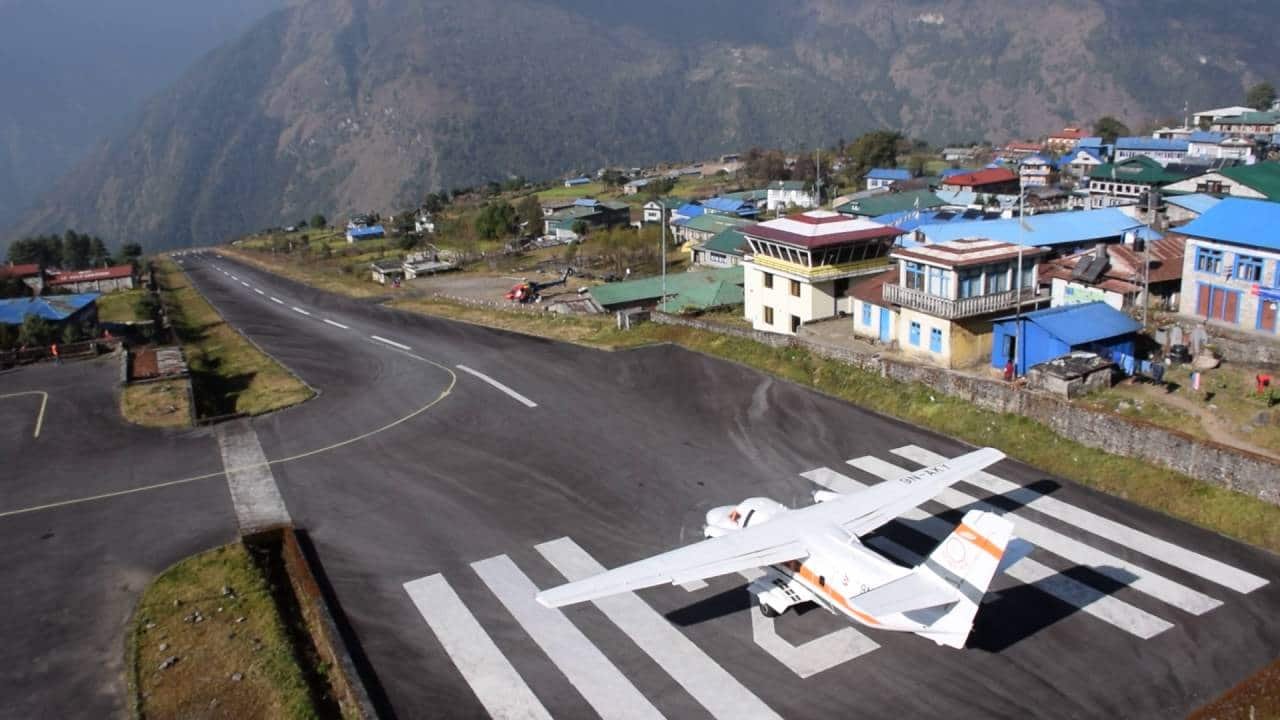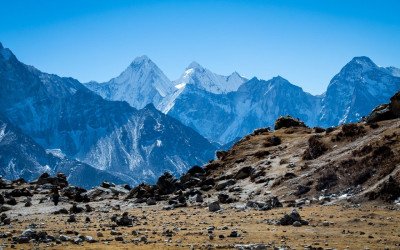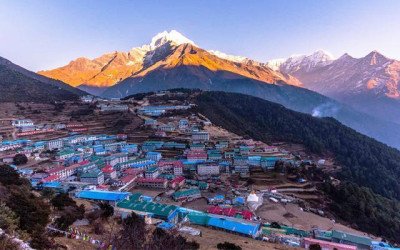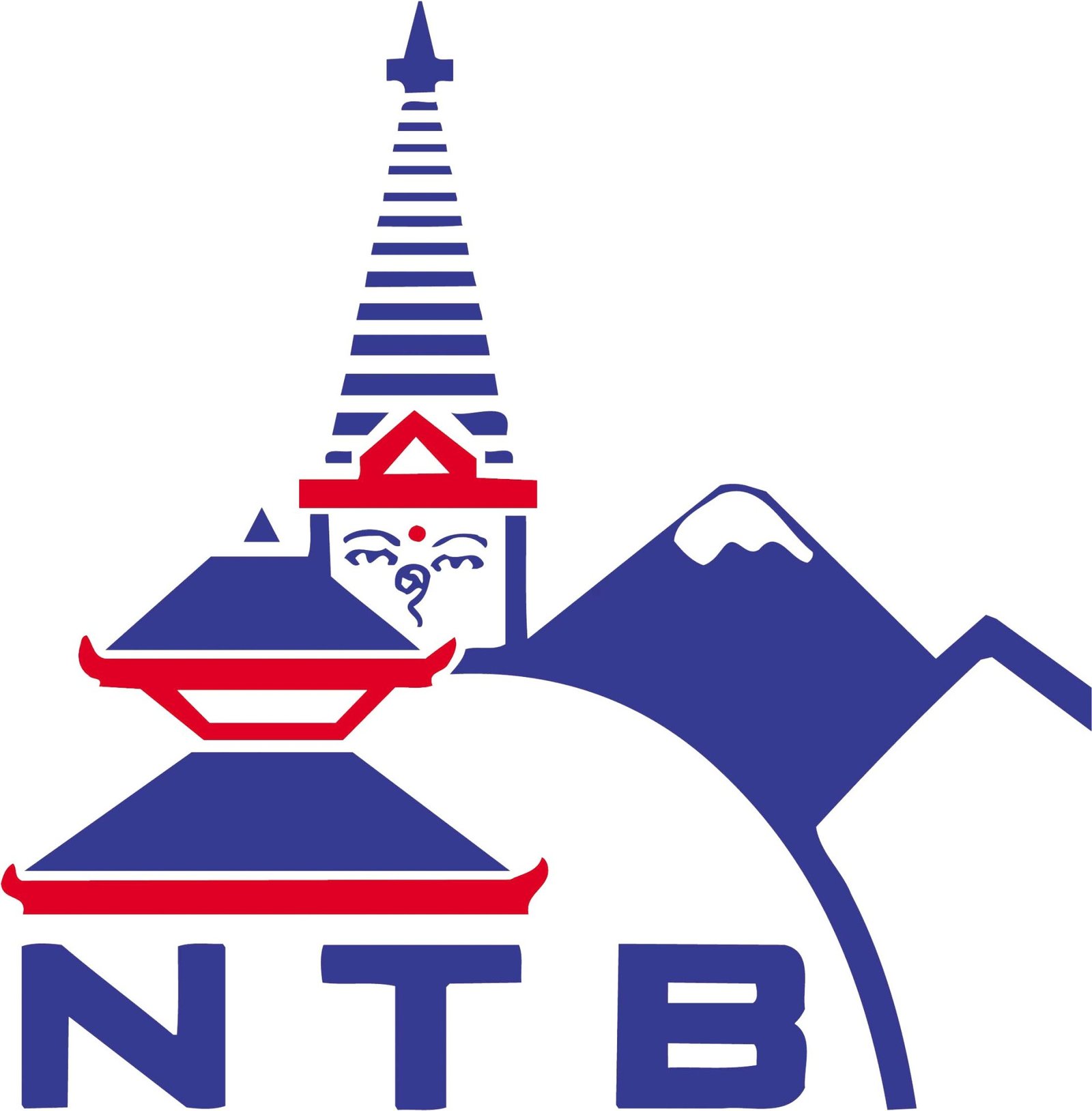- Registered Company
- More than Decade of Experience
- Customer Satisfaction is our motto
Trip Facts
-
Group Size1-15
-
Max Elevation6189 m
-
GradeDifficult
-
TransportationFlight/ Taxi/ Hike
-
AccommodationHotel/Lodge
-
Trip Length21 Days
-
Best MonthSpring and Autumn
-
WIFIAvaliable
-
Trip ModeAdvanced
-
MealBreakfast, Lunch and Dinner
-
Trekking StyleHike-Climb
-
Start FromKathmandu
-
End PointKathmandu
Outline Itinerary
Day 01: Arrival in Kathmandu
Day 02: Flight from Kathmandu (1,400 m) to Lukla (2,840 m) & Trek to Phakding (2,610 m)
Day 03: Trek from Phakding (2,610 m) to Namche Bazaar (3,440 m)
Day 04: Acclimatization Day in Namche Bazaar
Day 05: Trek from Namche Bazaar (3,440 m) to Tengboche (3,860 m)
Day 06: Trek from Tengboche (3,860 m) to Dingboche (4,410 m)
Day 07: Acclimatization in Dingboche
Day 08: Trek from Dingboche (4,410 m) to Lobuche (4,910 m)
Day 09: Trek from Lobuche (4,910 m) to Gorak Shep (5,190 m)
Day 10: Trek from Gorak Shep (5,190 m) to Everest Base Camp (5,364 m) and return to Gorak Shep
Day 11: Trek from Gorak Shep (5,190 m) to Everest Base Camp (5,364 m) and return to Gorak Shep
Day 12: Trek from Dingboche (4,410 m) to Chhukung (4,730 m)
Day 13: Trek from Chhukung (4,730 m) to Island Peak Base Camp (5,200 m)
Days 14-15: Island Peak Summit (6,189 m)
Day 16: Trek from Island Peak Base Camp (5,200 m) to Pangboche (3,930 m)
Day 17: Trek from Pangboche (3,930 m) to Namche Bazaar (3,440 m)
Day 18: Trek from Namche Bazaar (3,440 m) to Lukla (2,840 m)
Day 19: Flight from Lukla (2,840 m) to Kathmandu (1,355 m)
Day 20: Leisure Day and Farewell Celebration
Day 21: Departure
Altitude Map
This Altitude Map shows highest alttitude you will trek to each day.
Group Cost
| Group | Cost |
|---|---|
| 1-1 pax | $2200 |
| 2-4 pax | $1800 |
| 4-8 pax | $1700 |
| 9-15 pax | $1600 |
Package Included
- Airport transfers (Kathmandu)
- Accommodation (Kathmandu and during the trek/climb)
- Meals (Kathmandu, trek, and climb)
- Domestic flights (Kathmandu-Lukla-Kathmandu)
- Guides and porters
- Permits and fees
- Climbing equipment (basic gear for Island Peak)
- Safety equipment (first aid kit, oxygen, satellite phone)
- Local transport in Kathmandu
- Cultural activities (program and farewell dinner)
- Guided tours in Kathmandu
Package not Includes
- International flights
- Travel insurance
- Personal expenses (snacks, drinks, souvenirs)
- Visa fees
- Emergency evacuation costs
- Tips and gratuities
- Additional personal climbing gear
- Meals not specified in the itinerary
- Personal travel insurance
- Miscellaneous costs
Trip Overview
Island Peak with Everest Base Camp Trek is an exciting adventure that combines the classic trek to Everest Base Camp with the thrill of climbing Island Peak. Located in the heart of the Khumbu region, Island Peak (Imja Tse) stands at 6,189 meters and offers a challenging yet achievable summit for those looking to experience mountaineering.
The journey begins with a scenic flight to Lukla, followed by a trek through the picturesque Sherpa villages, lush forests, and high-altitude landscapes of the Everest region. Along the way, trekkers will visit iconic sites such as Namche Bazaar, Tengboche Monastery, and the Everest Base Camp itself, providing a deep cultural and natural immersion into the Himalayas.
The trek to Everest Base Camp allows you to experience the unique culture of the Sherpa people, with opportunities to explore their monasteries, meet local villagers, and enjoy the warm hospitality of the teahouses. As you ascend higher, the views of towering peaks like Ama Dablam, Lhotse, and Everest become increasingly spectacular.
Reaching Everest Base Camp, the starting point for climbers aiming to summit the world's highest peak, is a memorable experience, offering a sense of achievement and a close-up view of the Khumbu Icefall. The trek also includes a hike to Kala Patthar, a famous viewpoint that provides breathtaking panoramic views of Everest and the surrounding peaks, especially during sunrise and sunset.
The highlight of this adventure is the ascent of Island Peak, a non-technical climb that requires basic mountaineering skills. After acclimatizing and preparing at Everest Base Camp, trekkers make their way to Island Peak Base Camp.
The climb involves crossing glaciers, using ropes, and navigating crevasses, making it a perfect introduction to high-altitude mountaineering. The summit rewards climbers with stunning views of the Himalayas, including the nearby peaks of Nuptse, Lhotse, and Makalu.
This trek is ideal for those seeking a comprehensive Himalayan experience, combining the cultural richness of the Everest region with the challenge and excitement of a peak climb.
Highlights of Island Peak Climbing with Everest Base Camp Trek
- Scenic flight to Lukla
- Trekking through Sherpa villages
- Visiting Namche Bazaar
- Exploring Tengboche Monastery
- Reaching Everest Base Camp
- Hike to Kala Patthar viewpoint
- Stunning views of Ama Dablam, Lhotse, and Everest
- Climbing Island Peak
- Navigating glaciers and crevasses
- Panoramic views from the summit of Island Peak.
Detail Itinerary
Arrival in Kathmandu
Upon arrival at Kathmandu's Tribhuvan International Airport, you will be greeted by a representative who will assist you with your transfer to your hotel in the heart of the city. After check-in, you can relax and settle into your accommodation.
Depending on your arrival time, you might have the opportunity to explore the bustling streets of Thamel, known for its vibrant markets, diverse restaurants, and unique shops. In the evening, there will be a brief orientation about the trek, where you can meet your trekking guide and fellow trekkers.
This is also a great time to ask any last-minute questions and ensure you have all the necessary equipment for the adventure ahead.
Breakfast, Lunch and Dinner
Hotel
1355m

Flight from Kathmandu (1,400 m) to Lukla (2,840 m) & Trek to Phakding (2,610 m)
The day begins early with a short but exhilarating flight from Kathmandu to Lukla, the gateway to the Everest region. The 35-minute flight offers breathtaking views of the Himalayan range.
Upon landing at Lukla’s Tenzing-Hillary Airport (2,860m/9,383ft), you will meet the rest of the trekking team, including porters who will assist with carrying your gear.
From Lukla, the trek starts with a gentle descent through the Dudh Koshi Valley, passing through charming villages and terraced fields. After about 4 hours of trekking, you will arrive at Phakding (2,610 m), where you will stay overnight in a cozy lodge.
Breakfast, Lunch and Dinner
Lodge/Hotel
2613m

Trek from Phakding (2,610 m) to Namche Bazaar (3,440 m)
After breakfast in Phakding, the trek to Namche Bazaar begins. This day's trek is more challenging, involving several hours of walking uphill and crossing suspension bridges over the Dudh Koshi River.
As you move through the pine forest, you’ll pass through small settlements like Monjo, and enter the Sagarmatha National Park, a UNESCO World Heritage site. A steep climb up a forested hillside brings you to Namche Bazaar (3,440m/11,286ft), the bustling hub of the Khumbu region.
Namche Bazaar is known for its vibrant markets, bakeries, and shops. Here, you’ll stay in a lodge, allowing you to rest and acclimatize.
Breakfast, Lunch and Dinner
Lodge/Hotel
3440m

Acclimatization Day in Namche Bazaar
To aid in acclimatization, this day is spent in and around Namche Bazaar. You will take a short hike to the Everest View Hotel (3,800m/12,487ft), one of the highest luxury hotels in the world, offering panoramic views of Everest, Lhotse, and Ama Dablam. This hike not only provides stunning scenery but also helps your body adjust to the altitude.
After returning to Namche, you can explore the Sherpa Culture Museum and the Everest Photo Gallery. In the evening, attend a slide show program at the museum, which provides insights into the history, culture, and climbing expeditions in the Everest region.
Breakfast, Lunch and Dinner
Lodge/Hotel
3800m
Trek from Namche Bazaar (3,440 m) to Tengboche (3,860 m)
Leaving Namche Bazaar, the trail contours along the side of the valley high above the Dudh Koshi. The route offers stunning views of Everest, Lhotse, Nuptse, and Ama Dablam. After descending to the Dudh Koshi River at Phungi Thenga, the path climbs steeply through forests of rhododendron and pine to the Tengboche Monastery (3,850m/12,631ft).
Tengboche is the spiritual center of the Khumbu region and offers spectacular mountain views. You will visit the monastery and, if timing permits, witness a prayer ceremony. Overnight accommodation is in a lodge.
Breakfast, Lunch and Dinner
Lodge/Hotel
3850m
Trek from Tengboche (3,860 m) to Dingboche (4,410 m)
The trek from Tengboche to Dingboche takes you through some of the most picturesque landscapes in the region. You will descend through lush forests, cross the Imja Khola, and ascend past the village of Pangboche.
The trail continues through alpine meadows and pastures before reaching Dingboche (4,350m/14,271ft), known for its stone-walled fields. Along the way, you’ll have views of Mount Ama Dablam and Lhotse.
Dingboche is a perfect spot for acclimatization, with its wide-open valley surrounded by high peaks. You will stay overnight in a lodge.
Breakfast, Lunch and Dinner
Lodge/Hotel
4350m

Acclimatization in Dingboche
To acclimatize, you will spend the day in Dingboche, with an optional hike to Chhukung Ri (5,550m/18,209ft). This hike offers incredible views of Island Peak, Lhotse, Ama Dablam, and the surrounding valleys.
Climbing Chhukung Ri helps your body adapt to the high altitude, preparing you for the higher elevations to come. After returning to Dingboche, you can rest and explore the village, which has a number of lodges, bakeries, and shops. This day is crucial for proper acclimatization and reducing the risk of altitude sickness.
Breakfast, Lunch and Dinner
Lodge/Hotel
5550m
Trek from Dingboche (4,410 m) to Lobuche (4,910 m)
From Dingboche, the trail heads towards Lobuche. The initial part of the trek is relatively gentle, passing through meadows and small settlements. After a couple of hours, the trail climbs steeply to the terminal moraine of the Khumbu Glacier.
You will pass the memorials of climbers who lost their lives on Everest, a sobering and reflective moment of the trek. Continuing along the rugged terrain, you will reach Lobuche (4,930m/16,175ft), a small settlement with stunning views of Nuptse and Lobuche Peak. You will spend the night in a lodge.
Breakfast, Lunch and Dinner
Lodge/Hotel
4930m
Trek from Lobuche (4,910 m) to Gorak Shep (5,190 m)
Today’s trek is challenging but rewarding as you travel from Lobuche to Gorak Shep. The trail follows the glacial moraine of the Khumbu Glacier, with views of Everest, Nuptse, and other peaks. After a few hours, you will reach Gorak Shep (5,170m/16,961ft), the last settlement before Everest Base Camp.
After checking into a tea house, you can hike up to Kala Patthar (5,545m/18,192ft) for a panoramic view of Everest and the surrounding peaks. The ascent is steep and can be strenuous, but the view from the top is unforgettable. Then, return to Gorak Shep for the night.
Breakfast, Lunch and Dinner
Lodge/Hotel
5545m

Trek from Gorak Shep (5,190 m) to Everest Base Camp (5,364 m) and return to Gorak Shep
Early in the morning, you will set out for the highlight of the trek: Everest Base Camp (5,364m/17,598ft). The route follows the Khumbu Glacier and can be challenging due to the high altitude and rugged terrain.
Upon reaching Base Camp, you will be surrounded by the iconic peaks of the Himalayas, with the Khumbu Icefall and Everest looming above. Spend some time exploring the area, taking photos, and soaking in the atmosphere of the world's highest peak's base camp. After this memorable experience, you will return to Gorak Shep for the night.
Breakfast, Lunch and Dinner
Lodge/Hotel
5364m

Trek from Gorak Shep (5,190 m) to Everest Base Camp (5,364 m) and return to Gorak Shep
After breakfast at Gorak Shep, you will begin the descent back to Dingboche. The return journey allows you to appreciate the landscape from a different perspective, and the descent is easier on your body after days of ascent.
You will pass through Lobuche and continue down the valley, with stunning views all along the way. Reaching Dingboche, you will have time to rest and enjoy the comforts of a lower altitude. The lodge accommodation provides a cozy environment to reflect on the journey so far.
Breakfast, Lunch and Dinner
Lodge/Hotel
4410m
Trek from Dingboche (4,410 m) to Chhukung (4,730 m)
The trek from Dingboche to Chhukung is relatively short, taking about three hours. The trail ascends gently through the Imja Valley, with fantastic views of Island Peak and the surrounding mountains.
Chhukung (4,730m/15,518ft) serves as the staging point for the Island Peak climb. Here, you will meet the climbing guides and receive a briefing on the upcoming climb. The afternoon can be spent checking and preparing your climbing gear and taking a short hike to further acclimatize. Overnight in a lodge, you will rest and prepare for the challenging days ahead.
Breakfast, Lunch and Dinner
Lodge/Hotel
4730m

Trek from Chhukung (4,730 m) to Island Peak Base Camp (5,200 m)
Leaving Chhukung, you will trek to Island Peak Base Camp. The trail passes through glacial moraine and rugged terrain, gradually gaining altitude. Upon reaching Base Camp, you will set up camp and get ready for the climb.
The climbing guides will provide detailed instructions and conduct a gear check to ensure everything is in order. You will also receive training on the use of climbing equipment, such as crampons and ropes, essential for the ascent. The night is spent in tents, with an early start planned for the climb.
Breakfast, Lunch and Dinner
Lodge/Hotel
5200m
Island Peak Summit (6,189 m)
The climb to Island Peak (6,165m/20,226ft) is the pinnacle of this adventure. Starting in the early hours of the morning, you will ascend steep trails, cross glaciers, and navigate through crevasses. The climb involves using fixed ropes and crampons, with the final push to the summit being particularly challenging.
Reaching the summit, you will be rewarded with breathtaking views of the surrounding peaks, including Lhotse, Makalu, Baruntse, and Ama Dablam. After spending some time at the summit, you will descend back to Base Camp.
The climb takes approximately 10-12 hours, depending on conditions and your pace. The night is spent camping at Base Camp, celebrating the successful ascent.
Breakfast, Lunch and Dinner
Lodge/Hotel
6189m
Trek from Island Peak Base Camp (5,200 m) to Pangboche (3,930 m)
From Island Peak Base Camp, you will embark on a trek to Pangboche, which will take around six hours. This descent provides a refreshing change from the high-altitude environment and allows you to enjoy the beautiful landscapes and the sense of accomplishment from your climb.
The trail takes you through lush forests and traditional Sherpa villages, offering a glimpse into the local culture and daily life. Pangboche is a picturesque village known for its serene setting and the ancient Pangboche Monastery, which is worth a visit if time permits. You will stay overnight in a comfortable lodge, reflecting on the achievements of the past few days.
Breakfast, Lunch and Dinner
Lodge/Hotel
3930m

Trek from Pangboche (3,930 m) to Namche Bazaar (3,440 m)
The trek from Pangboche to Namche Bazaar is approximately five hours long and follows a mostly downhill route through the beautiful Khumbu Valley. Along the way, you'll cross several suspension bridges and pass through charming villages, gradually descending back to the bustling hub of Namche Bazaar (3,440m/11,286ft).
This vibrant town is a key stop on the Everest trail, offering a mix of local culture and modern amenities. You will stay in a lodge for the night, where you can enjoy the comforts of a lower altitude and perhaps explore the town’s markets and cafes.
Breakfast, Lunch and Dinner
Lodge/Hotel
3440m
Trek from Namche Bazaar (3,440 m) to Lukla (2,840 m)
On the final leg of your trek, you will travel from Namche Bazaar to Lukla, a journey that takes about seven hours. The trek is mostly downhill, following the Dudh Koshi River and passing through several small villages and lush forests.
As you approach Lukla (2,840m/9,317ft), you’ll feel a sense of accomplishment as you near the end of your trekking adventure. Lukla is the starting and ending point of your Everest trek, and you will spend the night in a lodge, reflecting on the incredible journey you’ve experienced.
Breakfast, Lunch and Dinner
Lodge/Hotel
2840m
Flight from Lukla (2,840 m) to Kathmandu (1,355 m)
After breakfast, you will take a short but scenic flight from Lukla back to Kathmandu. The 35-minute flight provides one last opportunity to enjoy stunning aerial views of the Himalayas.
Upon arrival in Kathmandu (1400 m), you will be transferred to your hotel. The rest of the day is free for you to relax or explore the city at your leisure. Kathmandu offers a range of cultural sites, bustling markets, and delicious cuisine.
Breakfast, Lunch and Dinner
Lodge/Hotel
1400m

Leisure Day and Farewell Celebration
This day is reserved for leisure and shopping in Kathmandu. You can visit local markets, shop for souvenirs, or explore cultural landmarks such as Swayambhunath (the Monkey Temple) or Durbar Square.
In the evening, you will attend a farewell dinner that includes a cultural program. This is a wonderful opportunity to celebrate your trekking achievements with your fellow trekkers and guides, enjoy traditional Nepali food, and experience local music and dance.
Breakfast, Lunch and Dinner
Lodge/Hotel
1355m
Departure
You will be transferred to Tribhuvan International Airport for your departure flight on your final day. Depending on your flight time, you may have some free time for last-minute shopping or sightseeing.
Your trek ends as you board your flight, leaving behind cherished memories of your Everest adventure and the stunning landscapes of the Himalayas.






















